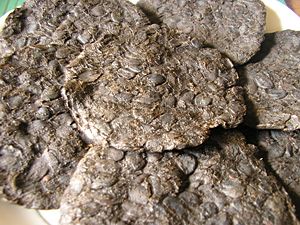Iru (food) facts for kids
Irú (pronounced Ee-roo) is a special ingredient used in cooking, especially by the Yoruba people and Edo people in Nigeria. It's made from locust beans that have been fermented. Fermentation is a natural process where tiny living things like bacteria change the beans, giving them a strong, unique flavor. Iru is like a condiment, which means it's added to food to give it extra taste, similar to how you might use salt or spices.
Iru is often used in traditional soups like egusi soup, okro soup, Ewedu soup, and ogbono soup. It adds a deep, savory flavor that many people love. In other parts of West Africa, especially among people who speak Manding languages, iru is known as sumbala.
Types of Iru
The Yoruba people have two main types of iru:
- Irú Wooro: This type is often used when making stews.
- Irú pẹ̀tẹ̀: This type is usually added to soups like ewedu and egusi soup.
Fresh vs. Dried Iru
Iru can be found in two forms: fresh or dried.
Fresh Iru
The fresh kind of iru usually comes wrapped in special leaves, like those used for moimoi. These leaves look and feel a bit like banana leaves. Fresh iru has a very strong smell, which is part of its unique appeal.
Dried Iru
The dried version of iru is often pressed into flat shapes or small cakes for easy selling. Dried iru has a milder flavor and less strong smell than the fresh kind. However, if you fry dried iru in cooking oil, much of its original flavor comes back. Dried iru is also great because it can be stored for a long time, especially in freezers.
What Makes Iru Special
The locust beans used to make iru are very nutritious. They are rich in important things like fats (about 29%), protein (about 35%), and carbohydrates (about 16%). This makes iru a good source of energy and nutrients, especially for people living in rural areas. It also provides calcium, which is good for strong bones.
During the fermentation process, the amount of natural sugars in the beans changes, and the amount of free amino acids (which are the building blocks of protein) increases. This process helps create the rich, savory taste that iru is known for.


